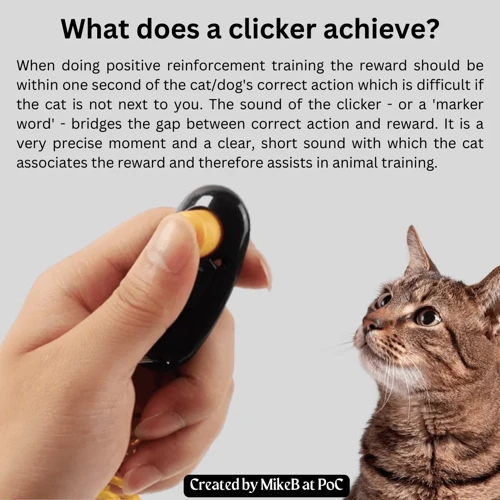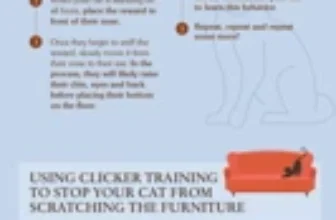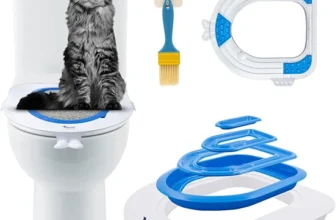As a devoted owner of an American Wirehair, you want to provide the best training possible for your beloved pet. Clicker training has become a popular choice among pet owners due to its effectiveness in promoting positive behavior, but it’s not foolproof. You may encounter some common mistakes that could undermine your efforts and leave your furry friend confused or disinterested. In this article, we’ll explore the most common mistakes to avoid in clicker training your American Wirehair, and provide strategies to overcome them. By the end of this article, you’ll have a clear understanding of how to improve your clicker training technique and help your feline companion become a well-behaved and happy pet.
Understanding Clicker Training

It can be perplexing to figure out how to train your American Wirehair cat, but using the right method can make your life as a pet owner much easier. One option that has gained popularity in recent years is clicker training. This method of training has been proven to be effective with all kinds of animals, including cats, and can make the training process more efficient and fun for both you and your furry friend. Not sure where to begin? Let’s explore the basics of clicker training and some common mistakes to avoid when using this technique with your American Wirehair. To learn more about the benefits of clicker training specifically for American Wirehair cats, check out our article on the subject.
What is Clicker Training?
Clicker training is a popular positive reinforcement training approach that has gained popularity in training American Wirehair. This method involves using a small plastic box that can produce a clicking sound whenever it is pressed. This sound is then associated with a reward or treat for the purpose of training and reinforcing good behavior. Below is an overview of clicker training and its key benefits.
| Benefits of Clicker Training |
|---|
| Increases accuracy of positive reinforcement By using a click to indicate the exact behavior that will earn a reward, clicker training helps reinforce the intended behavior. This increases the chances of the dog or cat learning the exact behavior you are seeking to reinforce. |
| Teaches complex behaviors in a simple way Clicker training breaks down complex behaviors into simple, easy to learn steps that can be understood by the pet. Instead of trying to teach an entire behavior at once, this approach allows you to focus on small steps and gradually build upon them until the desired behavior is achieved. |
| Encourages creativity and problem-solving skills Clicker training provides the pet with opportunities to be creative as they figure out what behaviors will earn them a click and a treat. This problem-solving can be helpful in the long run, as it teaches the animal to think in a more independent and autonomous way. |
| Strengthens the bond between owner and pet Clicker training provides an opportunity for bonding between you and your American Wirehair. By training together, you create a bond of trust and respect that can be strengthened over time. |
There are many benefits to clicker training, which makes it a popular method among animal trainers and owners. However, it is important to use this approach properly to gain the intended benefits.
How Does Clicker Training Work?
Clicker training is a positive reinforcement training method used to teach new behaviors to animals. The training process involves conditioning the animal to associate the sound of a clicker with a reward. Clicker training has been used effectively with dogs, cats, horses, and other animals. Here’s how Clicker Training works:
-Luring – Teaching the pet to follow the lure and go through the motions of the behavior by using food, toys, or other objects.
-Capturing – Rewarding your pet for performing a behavior spontaneously.
-Shaping – Breaking down the desired behavior into smaller actions and incremental steps to gradually teach the animal the correct behavior.
-Fading the Lure – This is where the visual cue or prompt will be gradually removed.
-Fading the Clicker – The treat-reinforced learning process will be enough and the clicker will not always required, only as reinforcement.
Clicker training works because it is a way to communicate with your pet without using physical punishment. It uses a reward-based approach to encourage good behavior, which helps to build trust and strengthen the bond between pet and owner. By using a clicker to reinforce positive behaviors, owners can communicate with their pets clearly and consistently, which helps the pet to learn more quickly and retain training skills longer.
If you want to learn more about how clicker training could be helpful in American Wirehair training, read our related article “Clicker Training Your American Wirehair”.
The Most Common Clicker Training Mistakes to Avoid

Embarking on the process of clicker training your American Wirehair can be an exciting and rewarding experience for both you and your feline friend. However, while clicker training has proven to be a highly effective training method, there are several common mistakes that many pet owners make along the way. In order to ensure that your training sessions are as constructive as possible, avoiding these mistakes is crucial. In this section, we will delve into some of the most common clicker training mistakes that you should aim to sidestep. By doing so, you can help your American Wirehair become the most well-behaved feline companion that it can be.
Mistake #1: Improper Timing of the Click
Proper timing of the click is crucial in clicker training, and improper timing can be a major mistake that hinders progress. This mistake is particularly important to avoid with American Wirehair kittens, as they are especially sensitive to improper training.
What is Improper Timing of the Click?
Improper timing of the click occurs when the click does not happen at the exact moment the desired behavior is exhibited. This is problematic because the click is meant to signify to the American Wirehair that they have done something correct and are on the right track.
If the click happens even a fraction of a second too early or too late, the American Wirehair may get confused and not understand which behavior the click was referring to.
| Common Errors of Improper Timing of the Click |
|---|
| Clicking too early |
| Clicking too late |
| Clicking for a different behavior than the one you intended |
Why is Improper Timing of the Click a Mistake?
Improper timing of the click is a mistake because it can lead to confusion and frustration for both the American Wirehair and the trainer. The American Wirehair may not understand what they did correctly and may become unmotivated to continue training if they do not receive clear feedback.
Additionally, this mistake can lead to the reinforcement of unwanted behaviors, as the American Wirehair may associate the click with an incorrect behavior if it is not timed correctly. This can cause setbacks in the training process and make it more difficult to achieve desired outcomes.
How to Avoid Improper Timing of the Click
To avoid improper timing of the click, it is important to be attentive and focused during training sessions. The trainer should be prepared to click as soon as the desired behavior is exhibited, rather than waiting or anticipating the behavior.
It may be helpful to practice clicking without the American Wirehair present, to ensure that the timing is accurate. This will also help to develop the necessary muscle memory required for quick and accurate clicking.
Avoiding the mistake of improper timing of the click requires patience, focus, and attention to detail. By being deliberate and consistent in training, it is possible to quickly achieve desired results with an American Wirehair kitten.
If you want to learn more about clicker training American Wirehair kittens, check out our guide here. You can also compare clicker training to other training methods in our article here.
Mistake #2: Inconsistent Clicking
Consistency is one of the key elements in clicker training your American Wirehair. Inconsistent clicking is a mistake that many pet owners make during training sessions. Consistency in clicker training means clicking at the right moment, using the same click sound every time, and rewarding your feline friend in the same way throughout the training process.
Inconsistent clicking can confuse your pet and make it tough for them to associate the click with the desired behavior. It is essential to use the same click sound every time when training your American Wirehair with a clicker. This consistency ensures your pet recognizes the sound as a signal that they have accomplished what you require of them. They are more likely to repeat the behavior if they know what to expect when they hear the click.
Using the clicker inconsistently can lead to ambiguous feedback towards your pet. They may not know if they are doing the right thing, which can delay their progress and create frustration. As a result, consistency is essential for reinforcing positive behavior and increasing the cat’s success rate, ultimately speeding up the training process.
The best way to avoid inconsistent clicking is to:
- Practice using the clicker until you feel comfortable with it and can use it almost automatically.
- Ensure that everybody involved in training your cat uses the same clicker sound, clicks at the same time, and provides the same positive reinforcement.
- Don’t click to correct behavior that you don’t want to encourage, Always click when you see a positive behavior that you want to reinforce.
Keep in mind that your American Wirehair is unique and different from other cats, so keep working within their unique learning capacity to get the best results. Remember, consistent clicking is key to clicker training success!
Mistake #3: Overuse of Treats
One of the most common mistakes that pet owners make when clicker training their American Wirehair is overusing treats. While treats are undeniably effective rewards for training, giving too many treats or using them inappropriately can actually weaken the effectiveness of clicker training.
The Negative Consequences of Overusing Treats in Clicker Training
Overuse of treats can have several negative consequences, including:
| Consequence | Description |
|---|---|
| Weight Gain and Health Issues | Overfeeding treats can result in your cat gaining excessive weight and experiencing health problems. |
| Dependency on Treats | If you give treats too often, your cat may become overly dependent on them and refuse to perform desired behaviors without the expectation of a reward. |
| Reduced Effectiveness of Treats as Rewards | Over time, your cat may become less motivated by treats and may not be as responsive to the clicker training process. |
Alternatives to Excessive Treat Use in Clicker Training
Fortunately, there are several alternatives to using treats excessively during clicker training sessions with your American Wirehair.
1. Use Verbal Praise: While treats are undeniably effective rewards, they are not the only way to reinforce positive behavior. Using verbal praise, such as a simple “good job” or “well done”, can have a similar motivating effect on your cat.
2. Incorporate Play: Some cats may be more motivated by playtime than by treats. In this case, incorporating play into your clicker training sessions can be an effective alternative to treats. You can use toys or games that your cat enjoys, such as chasing a toy, to reinforce positive behaviors.
3. Use Environmental Rewards: In some cases, the environment itself can be a rewarding experience for your cat. Examples of environmental rewards include allowing your cat to explore a new area or providing them with access to a favorite toy or perch.
Conclusion
While treats can be an effective tool in clicker training, overusing or misusing them can have negative consequences for your cat’s health and training progress. By incorporating alternative forms of rewards, such as verbal praise, play, and environmental rewards, you can provide a well-rounded training experience for your American Wirehair while avoiding the negative consequences of excessive treat use.
Mistake #4: Not Keeping Sessions Short
One common mistake that many pet owners make when training their American Wirehair is not keeping the training sessions short. It can be easy to get carried away and keep going with the training, especially when you start to see progress. However, allowing the training sessions to go on for too long can overtax your cat and lead to burnout.
Why is it important to keep training sessions short?
Training can be exhausting for your cat, both mentally and physically. Even though it may seem like your American Wirehair is having fun, they still need time to rest and recover. When they reach their limit, they may become anxious or agitated, and their training can suffer as a result.
How long should each training session be?
The ideal length of a training session for your American Wirehair will depend on their age, personality, and general level of fitness. As a general rule of thumb, aim for sessions that are between 10 and 15 minutes long. This will give your cat enough time to learn something new, without overtaxing their abilities.
How can you tell if your cat is getting tired?
It’s important to pay close attention to your cat’s behavior during training sessions. Signs that they may be getting tired include:
- Becoming less responsive to commands
- Appearing distracted or disinterested
- Becoming agitated or anxious
- Showing signs of physical fatigue, such as panting or heavy breathing
What should you do if your cat gets tired during training?
If you notice any of these signs, it’s time to end the session. Take a break, and give your cat plenty of time to rest and recover. This will help ensure that they are ready and eager to resume their training next time. Remember, consistency is key when it comes to cat training, but not at the cost of your cat’s well-being.
Mistake #5: Moving Too Quickly Through the Training
One of the biggest mistakes that American Wirehair cat owners make in clicker training is moving too quickly through the training, assuming that their cat will pick up on the commands quickly. However, this can be detrimental to the training and may cause frustration for both the owner and the cat.
| The Problem | The Solution |
| Owners may rush through commands, expecting their cat to understand and perform them flawlessly after only a few repetitions. | Owners should take the time to break down each command into manageable steps and allow their cat to master each step before moving on to the next. |
| Owners may become frustrated when their cat is not performing as expected and may resort to punishment, which is counterproductive in clicker training. | Owners should remember to maintain patience and positivity in their training sessions, using rewards and positive reinforcement to encourage progress. |
| Rapid progression can also result in the cat becoming confused and associating clicker training with stress and anxiety, resulting in resistance or refusal to participate in future sessions. | Owners should ensure that the cat is comfortable and engaged in each training session, taking breaks as needed and monitoring for signs of stress or discomfort. |
In order to avoid this mistake, it is important for owners to be patient and take the time to break down each command into simple steps that the cat can master before moving on. This ensures that the cat is comfortable and confident with each step of the process and is more likely to be successful in the training overall. By maintaining a positive and rewarding atmosphere during training sessions, owners can encourage their cat to continue to learn and improve, creating a strong bond between them and a well-trained American Wirehair cat.
Mistake #6: Not Recognizing Signs of Stress or Anxiety
One common mistake that many American Wirehair owners make while clicker training their pets is not identifying and addressing signs of stress or anxiety. Cats, like humans, have their unique personalities, and some can be more sensitive or anxious than others. It is crucial to keep an eye on how your American Wirehair responds to clicker training and make adjustments as needed.
Signs of stress or anxiety
| Behavioral signs of stress or anxiety: | Physical signs of stress or anxiety: |
|---|---|
|
– Hiding – Increased aggression – Excessive grooming – Loss of appetite – Avoidance – Destructive behavior |
– Panting – Dilated pupils – Licking lips – Flattened ears – Arching back – Hair standing on end |
Some common reasons for stress or anxiety during clicker training can include bad experiences in the past, loud noises, unfamiliar environments, or even an unfamiliar person performing the training.
How to address stress or anxiety
There are several ways American Wirehair owners can address stress or anxiety in their pets while clicker training. One approach is to start with basic training exercises in a comfortable and familiar environment and gradually introduce new terrains and distractions as they become more comfortable and confident with the training.
Another strategy is to provide plenty of positive reinforcement and rewards during the training sessions, such as treats and verbal praise, to help the American Wirehair associate training with positive experiences. It is also essential to keep training sessions short and to avoid pushing your cat too hard or moving too quickly through the training process.
Finally, if your American Wirehair continues to show signs of stress or anxiety during clicker training, it may be helpful to consult with a professional animal behaviorist who can provide more specialized advice and guidance.
How to Correct Clicker Training Mistakes
Once you identify the common mistakes you’re making in clicker training your American Wirehair, it’s essential to correct them to get the desired results. However, correcting these mistakes can be challenging, especially if you’re unsure how to go about it. Fret not! In this section, we’ll highlight some key strategies that you can use to correct clicker training mistakes and get your cat back on track towards successful training. So, let’s dive in and explore how you can turn things around!
Repetition and Consistency
One effective way to correct clicker training mistakes is through repetition and consistency. Repeated training sessions can help your American Wirehair cat to understand and remember what is expected of them. This will also help to ensure that any mistakes made during one training session can be corrected in subsequent sessions.
To maintain consistency, it is important to establish clear boundaries and guidelines for the training. This includes setting a consistent schedule for training sessions, using the same clicker sound every time, and defining the behaviors that will be reinforced.
Another key aspect of repetition and consistency is practice. Your cat might not pick up on behaviors right away, and it may take several practice sessions for them to get it right. It’s important to be patient and not get discouraged if your cat doesn’t catch on right away.
Using positive reinforcement and rewards can also help maintain consistency in your clicker training. By rewarding your cat for positive behaviors, they will be more likely to continue that behavior in future sessions.
Repetition and consistency are vital components of clicker training. By establishing clear guidelines, practicing regularly, and using positive reinforcement, you can help your American Wirehair cat learn and excel in clicker training.
Identifying and Addressing Issues
One of the most important steps in correcting clicker training mistakes is identifying and addressing any underlying issues that may be causing the mistakes. Here are some key steps to take:
- Observe your American Wirehair’s behavior: Take note of any patterns or behaviors that seem to be causing issues. For example, if your pet seems to be easily distracted, it may be necessary to train in a quieter, more controlled environment.
- Check your own behavior: It’s also important to consider whether your own behavior may be contributing to training issues. Are you consistent in your clicking and treating? Are you using the correct timing?
- Consult a professional: If your American Wirehair is exhibiting behavior issues such as aggression or fear, it’s important to consult a professional trainer or behaviorist. They can help diagnose the issue and provide guidance on how to work with your pet.
- Adjust your training approach: Once you have identified any issues, it’s time to adjust your training approach accordingly. This might involve more frequent and shorter training sessions, more positive reinforcement, or different methods of training altogether.
- Be patient: Finally, it’s important to remember that correcting clicker training mistakes takes time and patience. Be consistent in your approach, and be prepared to make adjustments as needed.
By following these steps and being proactive in identifying and addressing training issues, you can help ensure that your American Wirehair is successfully trained using clicker methods.
Using Positive Reinforcement and Rewards
When it comes to clicker training your American Wirehair, using positive reinforcement and rewards can greatly enhance the effectiveness of the training. Positive reinforcement involves rewarding your cat for behaving correctly, which will motivate them to repeat that behavior in the future.
Using rewards such as treats or toys can be very effective in clicker training, as they give your cat an incentive to perform the desired behavior. However, it is important to choose the right reward to ensure that your cat is motivated and interested. For example, some cats may prefer toys or playtime over treats.
To keep track of which rewards your cat responds to best, consider creating a rewards table. In the table, list different rewards and track how your cat responds to each one. This will help you identify which rewards are the most effective and motivating for your cat.
Table: Rewards Table
| Reward | Response |
|---|---|
| Treats | Very motivated |
| Toy mouse | Motivated |
| Playtime | Somewhat motivated |
In addition to rewards, positive reinforcement also involves praise and affection. When your cat performs a desired behavior, make sure to give them verbal praise, petting, or cuddles. This will create a positive association with the behavior and motivate them to repeat it in the future.
Using positive reinforcement and rewards can help make clicker training a positive and enjoyable experience for your American Wirehair, and can greatly increase the effectiveness of the training. By keeping track of the rewards that work best for your cat and providing plenty of praise and affection, you can help your cat learn quickly and confidently.
Conclusion
In conclusion, it’s important to understand the intricacies of clicker training and to avoid common mistakes when training your American Wirehair. Remember that clicker training requires proper timing and consistency in order to be effective. Overuse of treats can lead to weight gain and health problems, so be sure to use them sparingly. Short sessions that gradually increase in difficulty are more effective than long, intensive training sessions. It’s important to recognize signs of stress or anxiety in your cat and to address them promptly. Remember that repetition and consistency are key in correcting mistakes and reinforcing positive behavior. By using positive reinforcement and rewards, you can create a strong bond with your pet and effectively train them to be well-behaved, happy, and healthy. With patience, perseverance, and the proper techniques, your American Wirehair will become a well-trained companion that brings joy and happiness to your life for years to come.
Frequently Asked Questions
Can clicker training be used for every breed of dog?
Yes, clicker training can be used for any breed of dog, regardless of size, age, or breed.
What is the best size of treats to use in clicker training?
The treats used in clicker training should be small and easy to eat quickly, such as pea-sized pieces of soft treats or chopped up pieces of dry treats.
How many treats should I give during a clicker training session?
You should give no more than 10-15 treats during a clicker training session to prevent overfeeding and weight gain in your dog.
Is it necessary to use a clicker in clicker training?
No, you can use a verbal marker, such as the word “yes” or a whistle, instead of a clicker if your dog responds well to it.
How long should a clicker training session last?
A clicker training session should last no more than 10-15 minutes to prevent your dog from losing focus and becoming bored.
What should I do if my dog doesn’t respond to the clicker?
You can try using a different sounding clicker or switch to a verbal marker to see if your dog responds better to that.
Can clicker training be used to correct bad behavior in a dog?
Clicker training is primarily used to reinforce and teach good behavior, but can also be used to redirect and correct bad behavior with positive reinforcement techniques.
How often should I practice clicker training with my dog?
You should practice clicker training with your dog for short sessions daily to reinforce and maintain good behavior.
Should I click and treat for every desired behavior in clicker training?
It is recommended to click and treat for the first few times a desired behavior is performed, then gradually phase out the treats and rely on verbal praise and affection as reinforcement.
Can clicker training be used for cats or other pets?
Yes, clicker training can be used for cats, rabbits, and other pets in addition to dogs.







